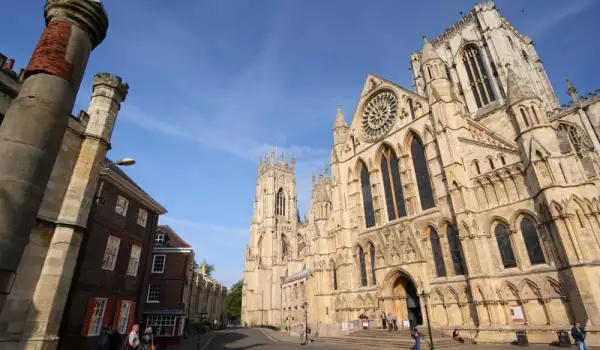York Minster

York Minster is considered the largest the largest medieval church in Britain and the largest Gothic cathedral in Northern Europe. Known as York Minster cathedral, it dominates the English city of York and is considered a masterpiece of medieval craftsmanship and architectural stained glass, unique like the Cologne Cathedral. To be built in the form in which it is today, York Minster is built over 250 years. Dedicated to St. Peter, York Cathedral is considered one of the wonders of Europe.
The first temple of this place was built of wood back in 627. Stone construction was completed in 637, in honor of St. Peter, but is in default to 670. In 741, York Minster was ruined by fire, but was restored in impressive form. Later on, there were constantly boiling local land struggles and battles for territories, which give little information about the temple, up to the 10th century. In the 11th century, the York cathedral was destroyed by the Danes, and then built again by the Normans.
From 1080 began construction of a modern cathedral. The length of the whole temple reached 111 meters. Once again, the cathedral was damaged in a fire in 1137 but was soon repaired. In 1154 the choir and crypt were reconstructed and a new chapel built. In the mid- 12th century, by order of Archbishop Walter de Gray, York cathedral was built in Gothic style, as it had to compete with the magnificent Canterbury Cathedral.
Beginning of the spectacular transformation of York Minster began in 1220 as north and south transept are the first new structures in the style of Gothic architecture. Although raised in early English Gothic style, the two parts of the cathedral walls are markedly different. At that time, the central tower with a wooden steeple appears. In 1472, the York Cathedral was completed and consecrated.
The English Reformation led to the ordination of the first Anglican Archbishop. This in turn accounts for much of the plundering of the riches of the cathedral and the loss of many of the lands of the church. Elizabeth I intentionally removed all traces in the Roman Catholic cathedral and tombs were destroyed, along with windows and altars.

Between 1730 and 1736 the interior of the temple is decorated entirely with variegated marble, but then again, a huge fire in 1840 destroyed and brought down the south tower. In 1984 York cathedral was in flames again, but after four years it had been restored. The eastern part of York Minster begins to be restored in 2007, as the cost of repairs amounted to 23 million pounds.
Remarkable structural part of the York Minster was the west window, built in 1338 over the Lady Chapel, completed in 1408, which is the largest medieval stained glass in the world. The south is marked by the famous Rose window.
Today an interesting part of the construction of the temple is the Octagonal Chapter house, built between 1260-1286. Here you can see amazing carvings, most of which date from 1270 to 1280, in the dungeons of the temple crypt are stored Norman, Viking and Roman treasures.
Be sure to climb the 275 stairs of the tower, from the top opens a comprehensive view of York. The York Cathedral is open to the public Monday to Saturday. There are tickets for the dungeon and tower, which are available at combined lower fares. While in the region of York, be sure to visit the Yorkshire Dales National Park, the beautiful Lake District and the impressive waterfall Cautley Spout, which is considered the highest in England.















